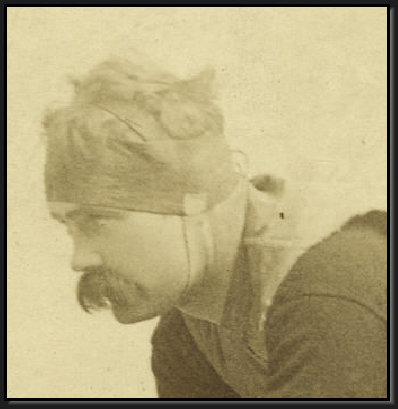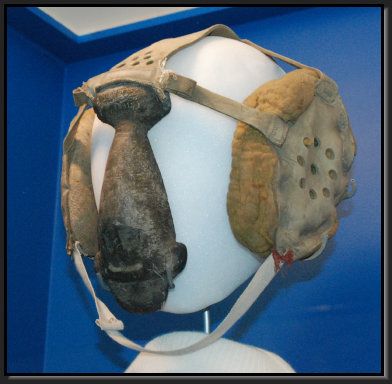Perform an internet search on "Who Invented the Football Helmet?," and you'll likely come up with one of three answers:
James Naismith, the "Father of Basketball," is said to have invented the football helmet to protect his damaged ears while playing football for the YMCA International Training College in 1891. Brian Cronin of the LA Times wrote an in depth history of Naismith's football exploits in his December 7, 2010 blog.
James Naismith
Photo of James Naismith wearing head protection, 1891 Heritage Auctions, December, 2006
Joseph Mason Reeves entered the U.S. Naval Academy in 1890 and played football for the Midshipmen until graduating in June, 1894. After suffering serious head injuries during his junior year, Reeves' doctor advised him to quit the sport out of fear that an additional blow to his head could cause "instant insanity or death." Undeterred, Reeves enlisted the help of a local shoemaker to construct a padded, mushroom-shaped raincap which, according to reports, he wore in the 1893 Army-Navy game. Reeves was photographed wearing his head protector in a team photo taken after the game (left). His contraption appears to be a hybrid between a stocking cap and a raincap that provided protection to the crown of his head but none to his ears or forehead.
There's no evidence that Reeves' cap caught on with other footballers of his era or that future helmets borrowed from its design. This fact begs the following question: "Is there a clear nexus between Reeves' cap and the modern football helmet?" The earliest raincap style helmet sold by a major sporting goods manufacturer was the Spalding No. 60 in 1900, but it included ear flaps, a hard leather shell, and ventilation holes that are not present on Reeves' cap. It would be a stretch to claim this design was influenced by Reeves.
Further, padded headgear for infants and for the protection of head injuries were introduced as early as the 16th century. While Reeves' use of a similar padded cap in a football game may have been a first for the game, it was not a new invention, nor was it specific for use in football. Reeves primary claim to fame was his decorated career as an admiral in the U.S. Navy, and today he is known as the "Father of Carrier Aviation." While his use of a padded cap is noteworthy in the history of the sport, it shouldn't bestow upon him the title of "Father of the Football Helmet."
There's no evidence that Reeves' cap caught on with other footballers of his era or that future helmets borrowed from its design. This fact begs the following question: "Is there a clear nexus between Reeves' cap and the modern football helmet?" The earliest raincap style helmet sold by a major sporting goods manufacturer was the Spalding No. 60 in 1900, but it included ear flaps, a hard leather shell, and ventilation holes that are not present on Reeves' cap. It would be a stretch to claim this design was influenced by Reeves.
Further, padded headgear for infants and for the protection of head injuries were introduced as early as the 16th century. While Reeves' use of a similar padded cap in a football game may have been a first for the game, it was not a new invention, nor was it specific for use in football. Reeves primary claim to fame was his decorated career as an admiral in the U.S. Navy, and today he is known as the "Father of Carrier Aviation." While his use of a padded cap is noteworthy in the history of the sport, it shouldn't bestow upon him the title of "Father of the Football Helmet."
Joseph Mason Reeves
James Naismith, the "Father of Basketball," invented the helmet while playing for the YMCA International Training College football team in 1891.
Joseph M. Reeves, U.S.N.A., after being warned that one more blow to the head may cause "instant insanity," had the first helmet made for him in 1893.
George Barclay, a national champion at Lafayette College, had a shoemaker construct the first helmet to protect his damaged ears in 1894.
1
2
3

So who has the best claim? The basketballer, the admiral, or the national champion? Perhaps, the inventor is someone who isn't listed on any website? To answer the question, it must first be broken down into basic parts:
Cronin argues that Naismith's "helmet" was, in fact, merely "some pieces of flannel" to protect Naismith's "cauliflower ear." Remarkably, a photo of Naismith wearing his contraption surfaced and sold on Heritage Auctions in December, 2006. The photo seems to support Cronin's position. While head wraps were frequently used by footballers to protect damaged ears as early as the mid 1880's, the Naismith photograph is the earliest image of a head protecting "apparatus" known to the author. It reveals that Naismith's "helmet" was essentially a wide flannel head wrap held in place with a strap under the chin and a strap across the crown of the head. The apparatus held Naismith's ears tight against his head, but afforded no protection to the brain or skull, which is the primary purpose of the modern football helmet. Naismith's invention is better described as an improvement to the head wrap, not the first "helmet." There is no evidence that Naismith's invention was utilized by other players or that future football head harnesses borrowed from its design.
1893 photo of Joseph Reeves wearing his padded cap
George "Rose" Barclay is also credited with inventing the football helmet in either 1894 or 1896, depending on the source. Barclay played football for Lafayette College from 1894 to 1896 and led the Leopards to an undefeated season and a share of a national championship (Princeton) in 1896. Lafayette outscored their opponents 242-10 in 1896. According to Lafayette College's official athletic site:
George Oliver Barclay
Barclay invented the first football helmet when the "threat of cultivating cauliflower ears" led him to have an Easton saddlemaker piece together three thick leather straps around his head during the 1894 football season. Also utilized by many of his teammates, Barclay's "head harness" gained notoriety at the Leopards' 1896 upset victory over Penn, which kept Lafayette's undefeated season intact en route to the National Championship.
Do three leather straps and ear pads constitute a helmet? Unlike the previous two contenders, an intriguing element of the Barclay claim is that his invention, initially conceived for the protection of an injury, caught on with his uninjured teammates. Could this be the genesis of headgear as a standard piece of football equipment?
A problem with Barclay's claim is that the description of his harness is remarkably similar to headgear already in commercial production in 1894. A.G. Spalding & Bros. introduced the No. 25 "Head Harness" in their 1894 Spalding Foot Ball Guide, which was distributed before the beginning of the 1894 football season. The No. 25 consisted of three strips of leather attached to two oversized ear pads and was the first head harness to be sold by any of the major sporting goods suppliers in the U.S. Spalding described the Head Harness as "Especially for protection to ears." The fact that the No. 25 was designed primarily to protect damaged ears is confirmed by the fact that a variation of the No. 25, the No. 15, came with only one ear pad. If the No. 25 was available for purchase prior to the 1894 season, production would likely have begin in late 1893 or early 1894, well before the unveiling of Barclay's invention. The No. 25, which provided ear padding but virtually no protection to the head, was sold by Spalding from 1894 until 1896. The only surviving example of a No. 25 Head Harness known to the author is on display at the Pro Football Hall of Fame in Canton, Ohio. Designed primarily as an "ear protector," the No. 25, and likewise Barclay's similarly constructed contraption, cannot be considered the first football "helmet."
A problem with Barclay's claim is that the description of his harness is remarkably similar to headgear already in commercial production in 1894. A.G. Spalding & Bros. introduced the No. 25 "Head Harness" in their 1894 Spalding Foot Ball Guide, which was distributed before the beginning of the 1894 football season. The No. 25 consisted of three strips of leather attached to two oversized ear pads and was the first head harness to be sold by any of the major sporting goods suppliers in the U.S. Spalding described the Head Harness as "Especially for protection to ears." The fact that the No. 25 was designed primarily to protect damaged ears is confirmed by the fact that a variation of the No. 25, the No. 15, came with only one ear pad. If the No. 25 was available for purchase prior to the 1894 season, production would likely have begin in late 1893 or early 1894, well before the unveiling of Barclay's invention. The No. 25, which provided ear padding but virtually no protection to the head, was sold by Spalding from 1894 until 1896. The only surviving example of a No. 25 Head Harness known to the author is on display at the Pro Football Hall of Fame in Canton, Ohio. Designed primarily as an "ear protector," the No. 25, and likewise Barclay's similarly constructed contraption, cannot be considered the first football "helmet."
No. 25 Head Harness Ad, Spalding Official Foot Ball Guide for 1894
No. 25 Head Harness, Pro Football Hall of Fame Display, Canton, OH
Close-up of Spalding No. 25 Head Harness
The inventor of the football helmet would, therefore, need to have designed or created a new and useful improvement to a protective head covering or enclosing headpiece specifically for use in the game of football and from which the evolution of the modern football helmet can be traced. This article will analyze the claims in support of each of our would-be inventors and again ask the question: "Who Invented the Football Helmet?"
noun
hel·met
1 : a covering or enclosing headpiece of ancient or medieval armor
2: any of various protective head coverings usually made of a hard material to resist impact
2: any of various protective head coverings usually made of a hard material to resist impact
invention
any art or process (way of doing or making things), machine, manufacture, design, or composition of matter, or any new and useful improvement thereof, or any variety of plant, which is or may be patentable under the patent laws of the United States.
Source: Merriam-Webster
Source: U.S. Patent and Trademark Office
c. 1900 Spalding No. 60 Head Harness, Legendary Auctions, August 2008


Spalding's Fall and Winter Sports Catalog for 1896-1897 states the No. 25 was "but one of many styles in head harness. We have made up special harness for Yale, Princeton, University of Pennsylvania and other leading colleges, and will be pleased to quote prices on any special design submitted."

noun







Harry Mason's Circa 1895 Spalding No. 25
Ear Protector
Ear Protector


Who Invented the Football Helmet?
....and Why it's not Who You Think
Chris Hornung, AntiqueFootball.com
January 15, 2017
January 15, 2017